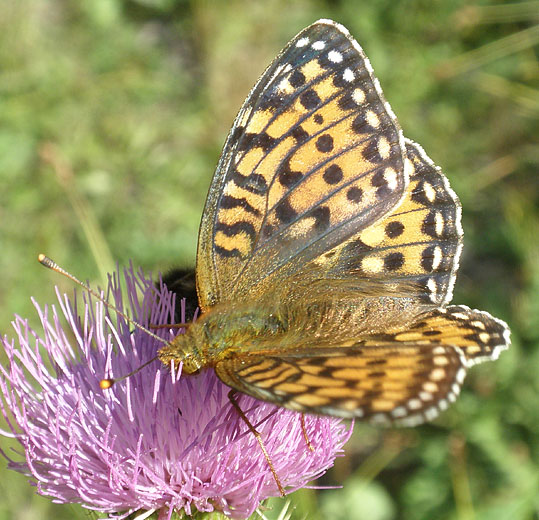The status of the Asian taxon alexandra should
be revised. It is currently regarded as a separate species; however,
there is cumulating evidence that either the present species is a
complex of at least three cryptic species, or the taxon alexandra could
be regarded only as a subspecies of Speyeria aglaja: (1) the genitalia
morphology is very similar between aglaja and alexandra, as originally
noted by
Dos Passos and Grey (1945), who already suggested that alexandra may only be a subtaxon of aglaja; (2) in the phylogenetic analysis by
De Moya et al. (2017)
alexandra is placed within the aglaja clade, thus suggesting that
either aglaja is a complex of species, or that alexandra is conspecific
with aglaja.
Papilio aglaja Linnaeus, 1758
Mesoacidalia aglaja (Linnaeus, 1758)
Argynnis aglaja (Linnaeus, 1758)
Speyeria aglaja (Linnaeus, 1758)
Argynnis charlotta
Mesoacidalia charlotta
Mesoacidalia aglaia auct. (misspelling)
Argynnis aglaia auct. (misspelling)
Additional German name: Großer Perlmuttfalter

Fig. 1: A possible subgeneric system for Speyeria as derived from the analysis by
De Moya et al. (2017). Only those species included in the analysis by
De Moya et al. (2017) are listed. Monophyletic groups were taken directly from the phylogram (Fig. 2 in
De Moya et al. (2017))
and were then ranked and named as subgenera according to the type
species (in boldface) they contain. Please note that this system does
not agree with the traditional concepts of these subgenera, but is
instead consistent with the phylogeny in
De Moya et al. (2017).
Please note: although most authors have regarded the name Neoacidalia
as an available name, its status remains to be clarified nomenclatorily,
because
Reuss (1926) has described the name in synonymy. The green dot denotes the species of the German fauna.
The present species has been placed in its own genus Mesoacidalia by some authors.
De Moya et al. (2017)
have performed a detailed phylogeny analysis and have shown that the
species aglaja together with other species traditionally placed in Mesoacidalia form a
paraphyletic group at the base of a large clade containing all North
American Speyeria species. In addition to being paraphyletic,
Mesoacidalia is not divided from Speyeria with a deep split.
De Moya et al. (2017)
therefore suggest that Mesoacidalia should not be ranked at the genus
level, and include it in Speyeria. The thorough analysis by
De Moya et al. (2017)
provides very convincing arguments for placing the present species in
the genus Speyeria and therefore I adopt this generic placement here. In
addition, it has been noted before that the unique bursa morphology of
American Speyeria species is virtually identical to the bursa morphology
of the present species, thus providing a convincing apomorphy of this
clade (
Grey 1989). If the concept of Speyeria as proposed by
De Moya et al. (2017)
is used to define monophyletic sub-groups, and if these monophyletic
groups are named according to the type species they contain of previously published
genus-group names, then the subgeneric system as shown in Fig. 1 can be
derived.
No information has been entered yet.
No information has been entered yet.
No information has been entered yet.

